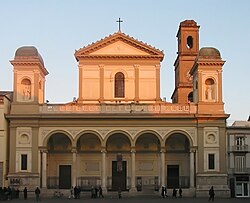Nola, Italy
| Nola | ||
|---|---|---|
| Comune | ||
| Metropolitan City of Naples | ||
 |
||
|
||
| Location of Nola in Italy | ||
| Coordinates: 40°55′34″N 14°31′39″E / 40.92611°N 14.52750°ECoordinates: 40°55′34″N 14°31′39″E / 40.92611°N 14.52750°E | ||
| Country | Italy | |
| Region | Campania | |
| Frazioni | Boscofangone, Cappella degli Spiriti, Casamarciano, Castelcicala, Catapano, Cinquevie, De Siervo, Eremo dei Camaldoli, Martiniello, Mascello, Mascia, Pagliarone, Piazzola, Piazzolla, Pigna Spaccata, Pollastri, Polvica, Poverello, Provisiero, Sarnella | |
| Government | ||
| • Mayor | Geremia Biancardi | |
| Area | ||
| • Total | 39 km2 (15 sq mi) | |
| Population (30 September 2015) | ||
| • Total | 34,349 | |
| • Density | 880/km2 (2,300/sq mi) | |
| Demonym(s) | Nolani | |
| Time zone | CET (UTC+1) | |
| • Summer (DST) | CEST (UTC+2) | |
| Postal code | 80035 and 80037 | |
| Dialing code | 081 | |
| Patron saint | St. Felix Martyr | |
| Saint day | November 15 | |
| Website | Official website | |
Nola is town and a modern municipality in the Metropolitan City of Naples in Italy. It lies on the plain between Mount Vesuvius and the Apennines. It is traditionally credited as the diocese that introduced bells to Christian worship. Illegal dumping of toxic wastes by the Camorra, however, has turned the surrounding area into a "Triangle of Death", with cancer rates far above the European average.
Excavations at Nola-Croce del Papa have uncovered extensive evidence of a small village quickly abandoned at the time of the Avellino Eruption in the 17th century BC. This powerful eruption from Mount Vesuvius caused the inhabitants to leave behind a wide range of pottery and other artifacts. The foundations of their buildings are also preserved in imprints among the mud left by the eruption.
Nola was one of the oldest cities of Campania, with its most ancient coins bearing the name Nuvlana. It was later said to have been founded by the Ausones, who were certainly occupying the city by c. 560 BC. It once vied in luxury with Capua. During the Roman invasion of Naples in 328 BC, Nola was probably occupied by the Oscans in alliance with the Samnites. Amid the Samnite War, the Romans took the town in 311 BC.
...
Wikipedia


